Experimental Study on Gas Production Capacity of Composite Reservoir Depletion in Deep Carbonate Gas Reservoirs
Abstract
:1. Introduction
2. Experimental Section
2.1. Experimental Materials
2.2. HPMI Method
2.3. High-Temperature and High-Pressure Depletion Seepage Test Method
2.3.1. Experimental Principle
2.3.2. Experimental Equipment
2.3.3. Experimental Protocol Design
2.3.4. Experimental Procedures
3. Reservoir Division Standard Based on Hpmi Results
3.1. Pore Characteristics by Capillary Pressure Curves of HPMI Results
3.2. Pore Characteristics by Pore Throat Distribution Curves of HPMI Results
3.3. Classification Criteria for HR and PR
4. Results and Discussion of Core Seepage Experiment
4.1. Influence of Well Deployment Mode on Gas Production Characteristics of CR
4.2. Influence of PRHPR on Gas Production Characteristics of CR
4.3. Influence of GWPPD on Gas Production Characteristics of CR
4.4. Influence of Water Saturation on Gas Production Characteristics of CR
5. Conclusions
- (1)
- Different types of reservoirs of the fourth member of the Dengying Formation in the Anyue gas field have unique microscopic pore structure characteristics: pore-type reservoirs have small pore-throats, poor connectivity, and are PRs; cavity-type and fracture-cavity-type reservoirs have large pore throats and good connectivity, which are HRs.
- (2)
- The gas production characteristics of gas wells are significantly different under different well location deployment modes. When gas wells are deployed on HRs, the gas production rate is fast, and the ultimate recovery rate of the reservoirs is high.
- (3)
- If the PRHPR is too small or too large, it will cause inconsistency between the recharge capacity of the PR and the high permeability of the HR, which is not conducive to the beneficial development of gas reservoirs.
- (4)
- Under the GWPPD of 3 MPa, the effect of “dynamic recharge” between the HR and PR is the best, and the ultimate recovery of the PR is the highest.
- (5)
- The seepage capacity of the reservoir is greatly affected by the formation of water. Some reserves of HRs and most of the reserves of PRs are sealed inside the reservoir under high water saturation and cannot be recovered.
Author Contributions
Funding
Data Availability Statement
Conflicts of Interest
Nomenclature
| HR | high-quality reservoirs |
| PR | poor-quality reservoirs |
| CR | composite reservoirs |
| HPMI | high-pressure mercury injection |
| PRHPR | permeability ratio of high-quality reservoir and poor-quality reservoir, % |
| GWPPD | gas well production pressure difference, MPa |
| CGP | cumulative gas production, ml |
| CGPC | cumulative gas production contribution, % |
| DRE | reserve recovery degree, % |
| RRE | reserve recovery efficiency, % |
References
- Hu, J.; Yang, S.; Wang, B.; Deng, H.; Wang, M.; Li, J.; Zhao, S.; Shen, B.; Gao, X.; Yang, K. Effect of Pore Structure Characteristics on Gas-Water Seepage Behaviour in Deep Carbonate Gas Reservoirs. Geoenergy Sci. Eng. 2024, 238, 212–881. [Google Scholar] [CrossRef]
- Yan, H.; Jia, A.; Meng, F.; Xia, Q.; Xu, W.; Feng, Q.; Luo, W.; Li, X.; Zhu, X.; Liu, Y. Comparative study on the reservoir characteristics and development technologies of two typical karst weathering-crust carbonate gas reservoirs in China. Geofluids 2021, 663–1006. [Google Scholar] [CrossRef]
- Jia, A.; Yan, H. Problems and countermeasures for various types of typical carbonate gas reservoirs development. Acta Pet. Sin. 2014, 35, 519–527. [Google Scholar]
- Yan, H.J.; He, D.B.; Jia, A.L.; Li, Z.P.; Guo, J.L.; Peng, X.; Meng, F.K.; Li, Y.X.; Zhu, Z.M.; Deng, H.; et al. Characteristics and development model of karst reservoirs in the fourth member of Sinian Dengying Formation in central Sichuan Basin, SW China. Pet. Explor. Dev. 2022, 49, 704–715. [Google Scholar] [CrossRef]
- Ma, X.H.; Yang, Y.; Wen, L.; Luo, B. Distribution and exploration direction of medium- and large-sized marine carbonate gas fields in Sichuan Basin, SW China. Pet. Explor. Dev. 2019, 46, 1–15. [Google Scholar] [CrossRef]
- He, D.B.; Yan, H.J.; Yang, C.C.; Wei, Y.S.; Zhang, L.J.; Guo, J.L.; Luo, W.L.; Liu, X.X.; Hu, D.; Xia, Q.Y.; et al. Gas reservoir characteristics and technical countermeasures for development in the fourth Member of Dengying Formation in Anyue gas field. Acta Pet. Sin. 2022, 43, 977–988. [Google Scholar]
- Xu, Y.; Tan, X.; Li, X.; Liu, Q. Blasingame production decline and production prediction model of inclined well in triple-porosity carbonate gas reservoir. J. Nat. Gas Sci. Eng. 2021, 92, 103–983. [Google Scholar] [CrossRef]
- Xie, X.; Lu, H.; Deng, H.; Li, H. Characterization of unique natural gas flow in fracture-vuggy carbonate reservoir: A case study on dengying carbonate reservoir in China. J. Pet. Sci. Eng. 2019, 182, 106–243. [Google Scholar] [CrossRef]
- Tian, X.W.; Peng, H.L.; Wang, Y.L.; Yang, D.L.; Sun, Y.T. Analysis of reservoir difference and controlling factors between the platform margin and the inner area of the fourth member of Sinian Dengying Formation in Anyue Gas Field, central Sichuan. Nat. Gas Geosci. 2020, 31, 1225–1238. [Google Scholar]
- Wang, L.; Yang, S.; Liu, Y.; Xu, W.; Deng, H.; Meng, Z.; Han, W.; Qian, K. Experiments on gas supply capability of commingled production in a fracture-cavity carbonate gas reservoir. Pet. Explor. Dev. 2017, 44, 824–833. [Google Scholar] [CrossRef]
- Wang, Z.C.; Zhao, W.Z.; Hu, S.Y.; Xu, A.N.; Jiang, Q.C.; Jiang, H.; Huang, S.P.; Li, Q.F. Control of tectonic differentiation on the formation of large oil and gas fields in craton basins: A case study of Sinian–Triassic of the Sichuan Basin. Nat. Gas Ind. 2017, 37, 9–23. [Google Scholar] [CrossRef]
- Zhang, Y.X.; Yang, S.L.; Zhang, Z.; Li, Q.; Deng, H.; Chen, J.Y.; Geng, W.Y.; Wang, M.Y.; Chen, Z.X.; Chen, H. Multiscale pore structure characterization of an ultra-deep carbonate gas reservoir. J. Pet. Sci. Eng. 2022, 208, 109–751. [Google Scholar] [CrossRef]
- Wang, L.; He, Y.M.; Deng, H.; Liu, Y.C.; Xu, W. Pore structure characteristics of an ultradeep carbonate gas reservoir and their effects on gas storage and percolation capacities in the deng iv member, gaoshiti-moxi area, sichuan basin, sw China. Mar. Pet. Geol. 2020, 111, 44–65. [Google Scholar] [CrossRef]
- Zhou, Y.; Yang, F.; Ji, Y.; Zhang, C. Characteristics and controlling factors of dolomite karst reservoirs of the sinian dengying formation, central sichuan basin, southwestern china. Precambrian Res. 2020, 343, 105708. [Google Scholar] [CrossRef]
- Li, J.; Yang, C.L.; Xie, W.R.; Rui, Y.R.; Wang, X.B.; Zhang, L.; Xie, Z.Y.; Guo, Z.Q. Differences of natural gas accumulation and play fairways in the marginal zone and interior of Sinian platform in Anyue gas field, Sichuan Basin. Oil Gas Geol. 2023, 44, 34–45. [Google Scholar]
- Zhang, M.; Dai, X.F.; Pang, C.X.; Jiang, L.; Geng, C.; Xu, Y.P. Identification and application of the gas reservoirs in the intra-platform of the Sinian Dengying Formation in central Sichuan Basin. Nat. Gas Geosci. 2021, 32, 764–771. [Google Scholar]
- Guo, C.Q.; Li, F.M.; Liu, H.N.; Xia, Z.H.; Liu, X.W.; Fan, H.L.; Liu, L.L. Analysis of quantitative relationship between gas offtake and plateau duration of natural gas reservoir. Acta Pet. Sin. 2009, 30, 908–911. [Google Scholar]
- Yan, H.J.; Deng, H.; Wan, Y.J.; Yu, Q.C.; Xia, Q.Y.; Xu, W.; Luo, R.L.; Chen, M.H.; Yan, Y.J.; Zhang, L.; et al. The gas well productivity distribution characteristics in strong heterogeneity carbonate gas reservoir in the fourth Member of Dengying Formation in Moxi area, Sichuan Basin. Nat. Gas Geosci. 2020, 31, 1152–1160. [Google Scholar]
- Gao, S.S.; Liu, H.X.; Ren, D.; Hu, Z.M.; Ye, L.Y. Productivity equation of fractured-cave carbonate reservoirs and its influencail factors. Nat. Gas Ind. 2015, 35, 48–54. [Google Scholar]
- Zhu, H.Y.; Hu, Y.; Zhu, W.Y.; Wang, F.J.; Luo, R.L. Physical simulation technology for gas reservoir development behavior analysis. Oil Drill. Prod. Technol. 2010, 32, 54–57. [Google Scholar]
- Yang, J.; Kang, Y.L.; Wang, Y.Z.; Guo, H.Z. An experimental study of gas mass-transfer for fractured tight sand gas reservoirs. Nat. Gas Ind. 2010, 30, 39–41. [Google Scholar]
- Zhang, X.Y.; Wang, J.J.; Wang, G.; Wang, N.; Liu, Z.X.; Gong, H.Y.; Wang, W.G. Gas production path of coalbed methane reservoir:A case study of Mabidong Block, southern Qinshui Basin. Pet. Geo. Recy. Eff. 2020, 27, 137–142. [Google Scholar]
- Hu, Y.; Jia, Y.Z.; He, D.B.; Wang, J.P.; Li, Z.C.; Zhou, M.F.; Wei, K.Y.; Jiang, L.J.; Xu, X.; Jiao, C.Y.; et al. Characterization method of gas reservoir heterogeneity and physical simulation experiment of production. Nat. Gas Geosci. 2022, 33, 297–302. [Google Scholar]
- Gong, Y.J.; Liu, S.B.; Zhao, M.J.; Xie, H.B.; Liu, K.Y. Characterization of micro pore throat radius distribution in tight oil reservoirs by NMR and high pressure mercury injection. Pet. Geol. Exp. 2016, 38, 389–394. [Google Scholar]
- Kong, X.X.; Xiao, D.S.; Jiang, S.; Lu, S.F.; Sun, B.; Wang, J.M. Application of the combination of high-pressure mercury injection and nuclear magnetic resonance to the classification and evaluation of tight sandstone reservoirs: A case study of the Linxing Block in the Ordos Basin. Nat. Gas Ind. 2020, 40, 38–47. [Google Scholar] [CrossRef]
- Ning, C.X.; Jiang, Z.X.; Gao, Z.Y.; Li, Z.; Zhu, R.F.; Su, S.Y.; Li, T.W.; Wang, Z.; Huang, R.Z.; Chen, L. Quantitative evalution of pore connectivity with nuclear magnetic resonance and high pressure mercury injection: A case study of the lower section of Es3 in Zhanhua sag. J. China Univ. Min. Technol. 2017, 46, 578–585. [Google Scholar]
- 20067102-T-469; Measuring the Pore Size Distribution and Porosity of Solid Materials by Mercury Intrusion and Gas Adsorption Method Part 1: Mercury Intrusion Method; China National Institute of Standardization: Beijing, China, 2008.
- Cheng, Z.; Ning, Z.; Wang, Q.; Zhang, W. The effect of pore structure on non-darcy flow in porous media using the lattice boltzmann method. J. Pet. Sci. Eng. 2019, 172, 391–400. [Google Scholar] [CrossRef]
- Muljadi, B.P.; Blunt, M.J.; Raeni, A.Q.; Bijeljic, B. The impact of porous media heterogeneity on non-darcy flow behaviour from pore-scale simulation. Adv. Water Resour. 2016, 95, 329–340. [Google Scholar] [CrossRef]
- Balhoff, M.T.; Wheeler, M.F. A predictive pore-scale model for non-Darcy flow in porous media. SPE J. 2009, 14, 579–587. [Google Scholar] [CrossRef]
- Wang, L.; Yang, S.L.; Peng, X.; Deng, H.; Li, L.X.; Meng, Z.; Qian, K.; Wang, Q. Visual experiments on the occurrence characteristics of multi-type reservoir water in fracture-cavity carbonate gas reservoir. Acta Pet. Sin. 2018, 39, 686–696. [Google Scholar]
- Zhang, J.; Li, X.Z.; Gao, S.S.; Ye, L.Y.; Liu, H.X.; Zhu, W.Q.; Fang, F.F. Water production mechanism of tight sandstone gas reservoir and its influence on percolation capacity. Nat. Gas Geosci. 2019, 30, 1519–1530. [Google Scholar]
- Sima, L.Q.; Wang, C.; Wang, L.; Wu, F.; Ma, L.; Wang, Z.J. Effect of pore structure on the seepage characteristics of tight sandstone reservoirs: A case study of Upper Jurassic Penglaizhen Fm reservoirs in the western Sichuan Basin. Nat. Gas Ind. 2016, 36, 18–25. [Google Scholar] [CrossRef]

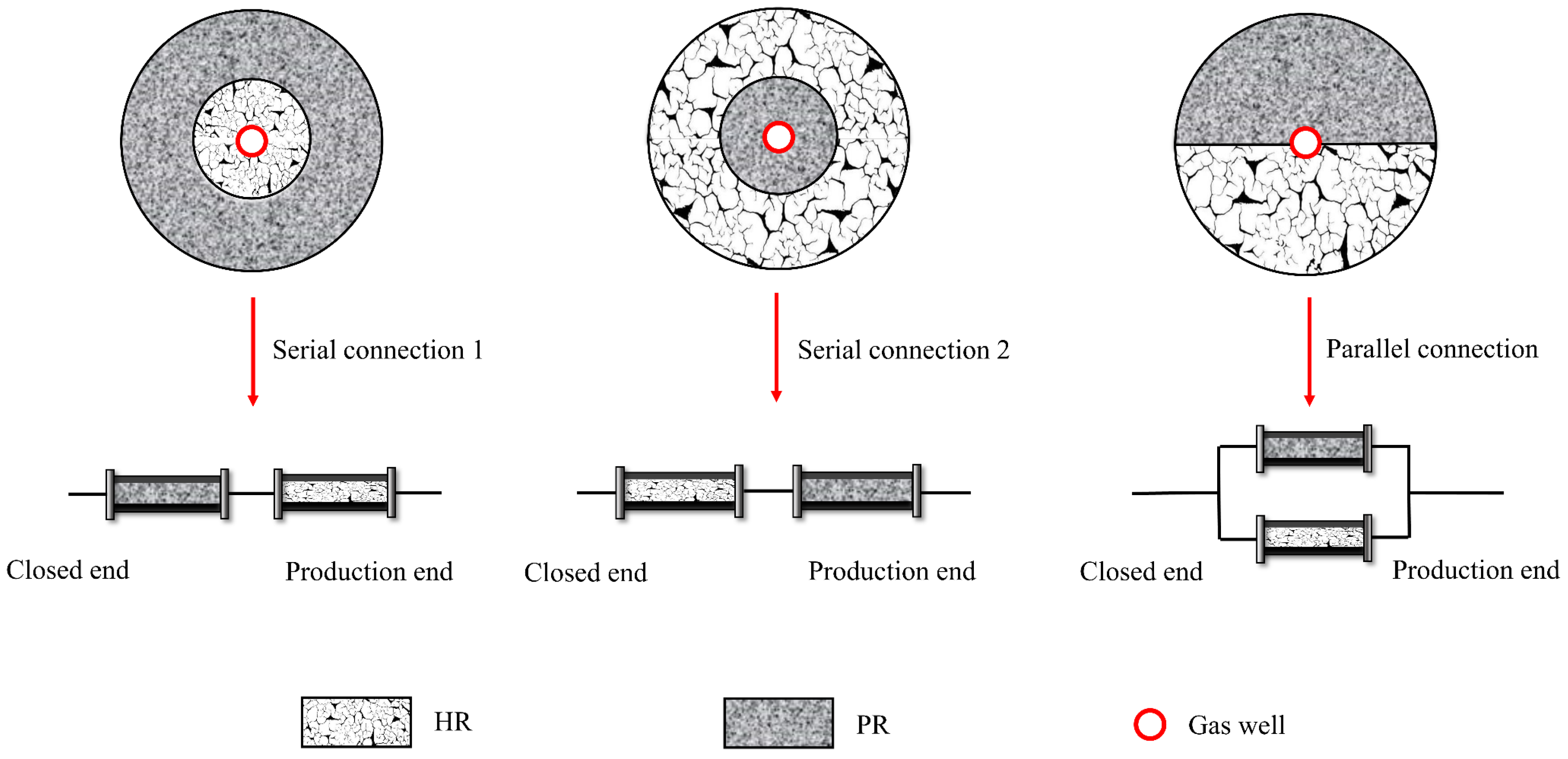
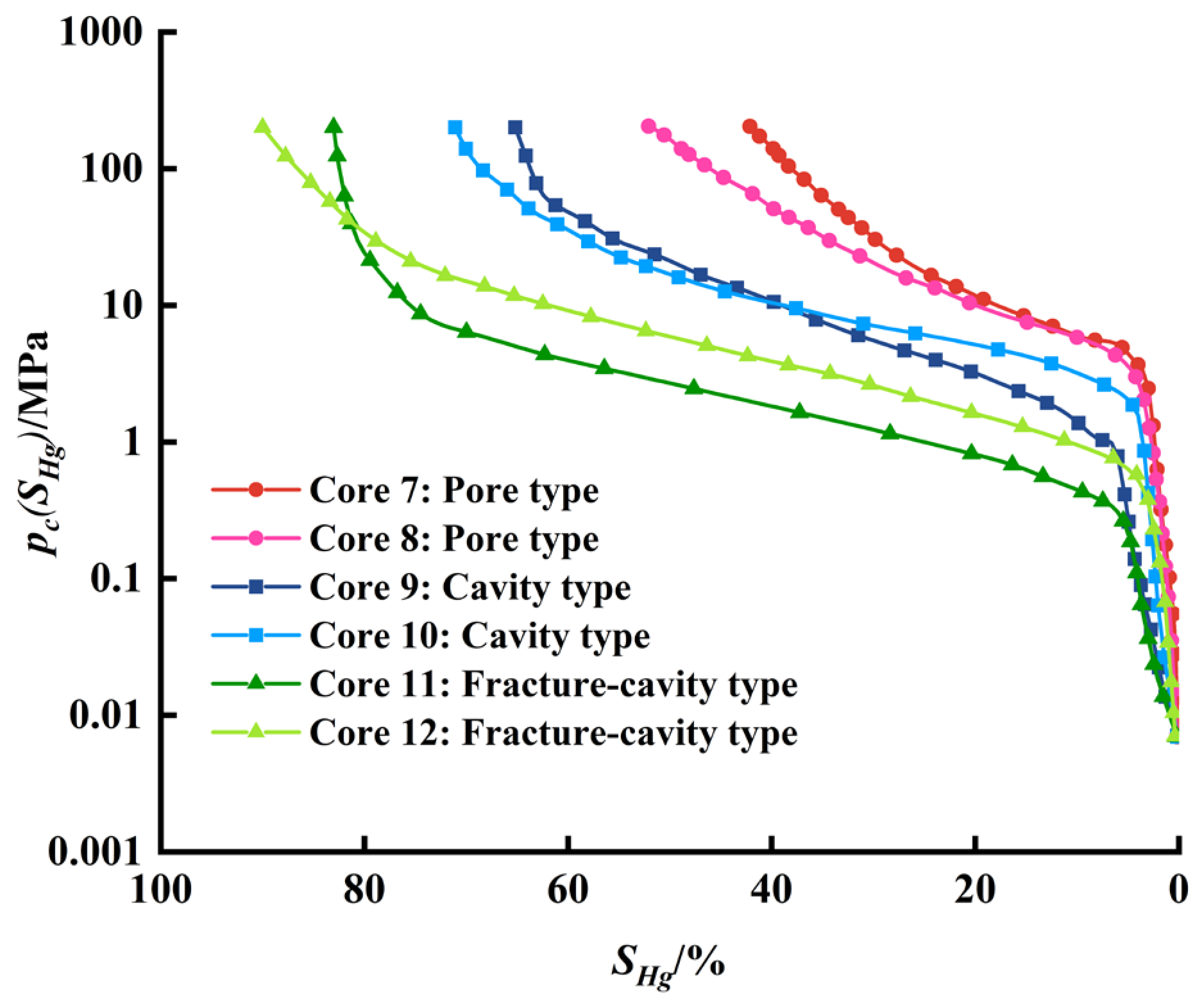
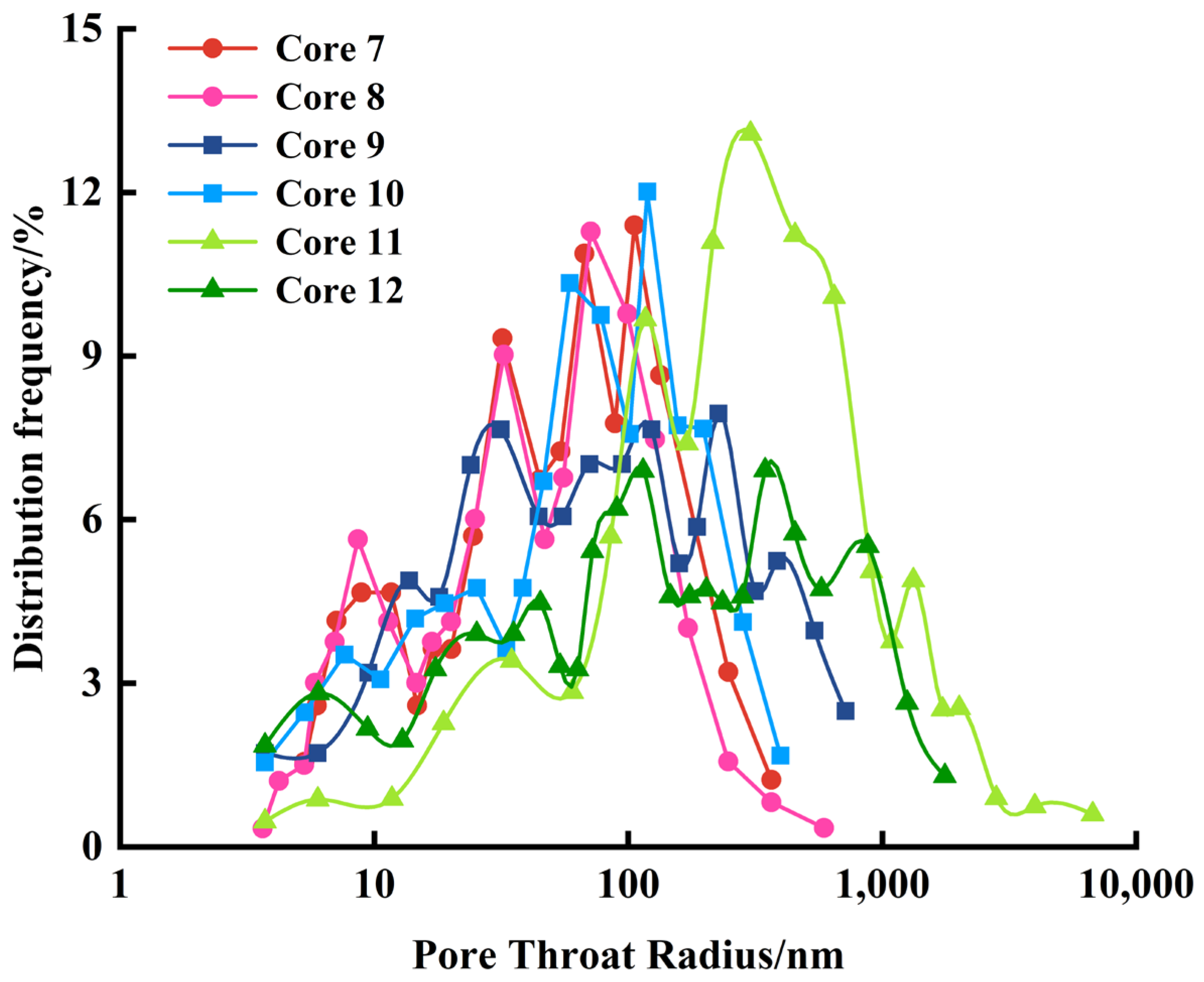


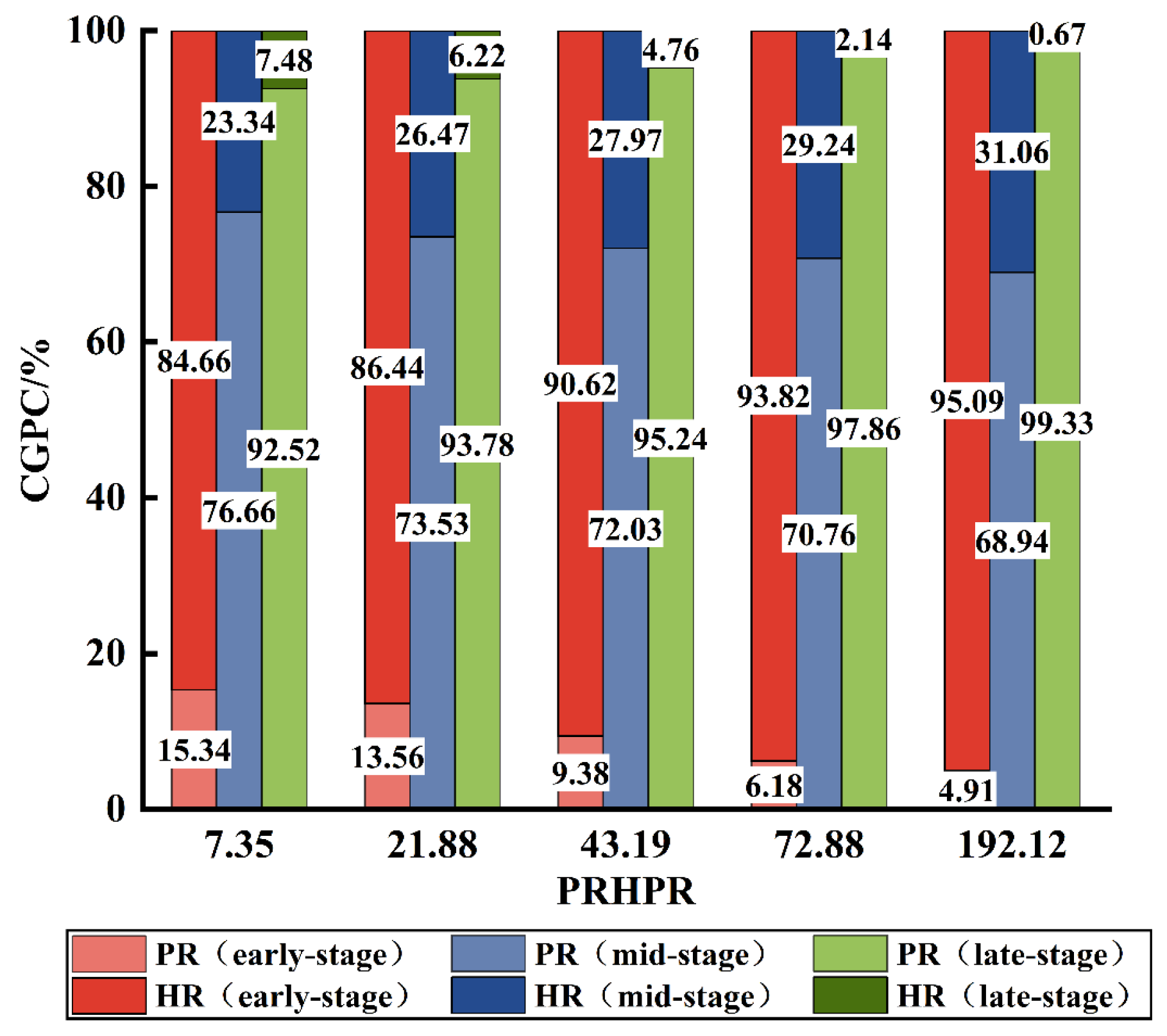
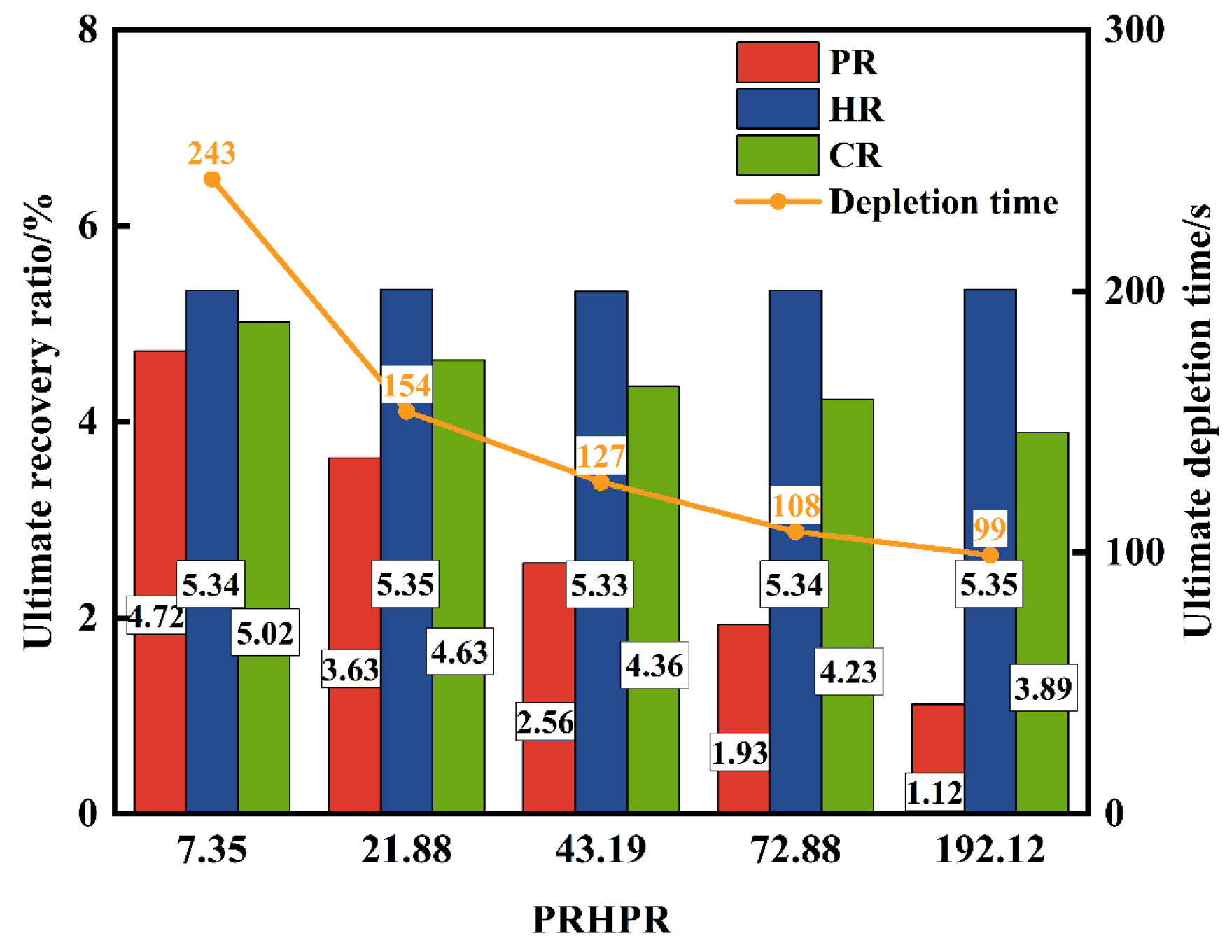


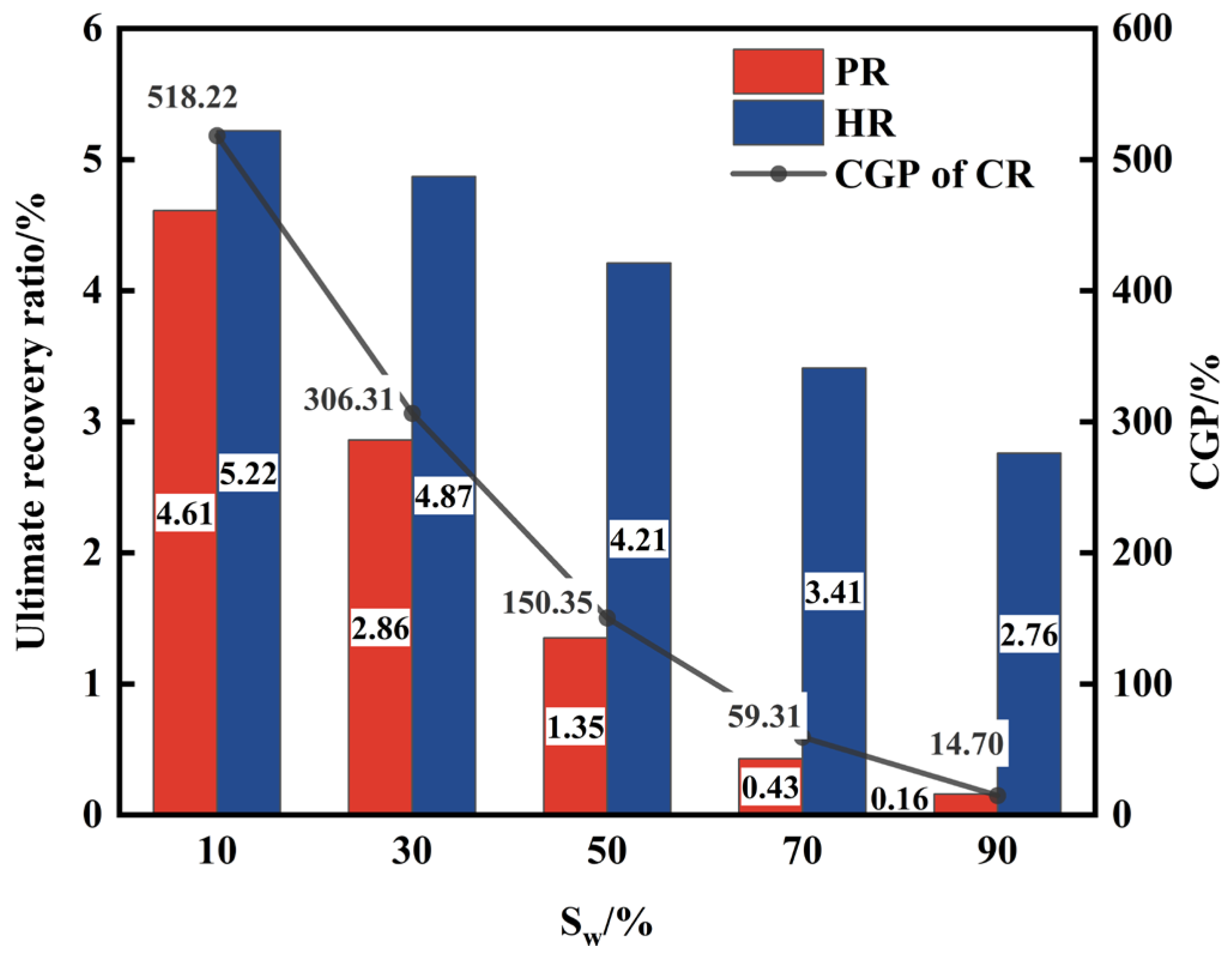
| Sample Number | Length/cm | Diameter/cm | Permeability/10−3 μm2 | Porosity/% | Core Size | Core Type | Core Quality |
|---|---|---|---|---|---|---|---|
| 1 | 10.11 | 6.60 | 0.026 | 2.58 | full diameter | Pore type | Poor-quality |
| 2 | 7.00 | 6.71 | 0.191 | 3.62 | full diameter | Cavity type | High-quality |
| 3 | 8.361 | 6.53 | 0.569 | 3.17 | full diameter | Cavity type | High-quality |
| 4 | 6.52 | 6.81 | 1.123 | 3.59 | full diameter | Cavity type | High-quality |
| 5 | 7.16 | 6.56 | 1.895 | 4.03 | full diameter | Fracture-cavity type | High-quality |
| 6 | 9.77 | 6.57 | 4.995 | 4.31 | full diameter | Fracture-cavity type | High-quality |
| 7 | 6.60 | 2.483 | 0.009 | 2.01 | plunger | Pore type | Poor-quality |
| 8 | 6.71 | 2.482 | 0.013 | 1.89 | plunger | Pore type | Poor-quality |
| 9 | 6.53 | 2.503 | 0.141 | 3.59 | plunger | Cavity type | High-quality |
| 10 | 6.20 | 2.497 | 0.572 | 3.87 | plunger | Cavity type | High-quality |
| 11 | 6.56 | 2.513 | 2.471 | 3.34 | plunger | Fracture-cavity type | High-quality |
| 12 | 6.57 | 2.494 | 5.092 | 3.41 | plunger | Fracture-cavity type | High-quality |
| Type | PH | Relative Density | Total Salinity (mg/L) | Na+, Ka+ | Ca2+,Mg2+ | Ba2+, Sr2+ | Cl− | Br−, I− | B3− |
|---|---|---|---|---|---|---|---|---|---|
| CaCl2 | 4.62 | 1.0576 | 75,312 | 12,486 | 12,822 | 593 | 49,023 | 203 | 185 |
| Research Content | Connection Method | Core Combination | Water Saturation/% | Experimental Differential Pressure/MPa | PRHPR |
|---|---|---|---|---|---|
| Well deployment mode | Serial connection 1 | 1 + 2 | 10 | 3 | 7.35 |
| Serial connection 2 | 1 + 2 | 10 | 3 | 7.35 | |
| Parallel connection | 1 + 2 | 10 | 3 | 7.35 | |
| PRHPR | Serial connection 1 | 1 + 3 | 10 | 3 | 21.88 |
| 1 + 4 | 10 | 3 | 43.19 | ||
| 1 + 5 | 10 | 3 | 72.88 | ||
| 1 + 6 | 10 | 3 | 192.12 | ||
| GWPPD | Serial connection 1 | 1 + 2 | 10 | 1 | 7.35 |
| 1 + 2 | 10 | 5 | 7.35 | ||
| 1 + 2 | 10 | 7 | 7.35 | ||
| Water saturation | Serial connection 1 | 1 + 2 | 30 | 3 | 7.35 |
| 1 + 2 | 50 | 3 | 7.35 | ||
| 1 + 2 | 70 | 3 | 7.35 | ||
| 1 + 2 | 90 | 3 | 7.35 |
Disclaimer/Publisher’s Note: The statements, opinions and data contained in all publications are solely those of the individual author(s) and contributor(s) and not of MDPI and/or the editor(s). MDPI and/or the editor(s) disclaim responsibility for any injury to people or property resulting from any ideas, methods, instructions or products referred to in the content. |
© 2024 by the authors. Licensee MDPI, Basel, Switzerland. This article is an open access article distributed under the terms and conditions of the Creative Commons Attribution (CC BY) license (https://creativecommons.org/licenses/by/4.0/).
Share and Cite
Li, Y.; Qian, Q.; Zhong, A.; Yang, F.; Lu, M.; Zhang, Y.; Jiang, A. Experimental Study on Gas Production Capacity of Composite Reservoir Depletion in Deep Carbonate Gas Reservoirs. Processes 2024, 12, 1546. https://doi.org/10.3390/pr12081546
Li Y, Qian Q, Zhong A, Yang F, Lu M, Zhang Y, Jiang A. Experimental Study on Gas Production Capacity of Composite Reservoir Depletion in Deep Carbonate Gas Reservoirs. Processes. 2024; 12(8):1546. https://doi.org/10.3390/pr12081546
Chicago/Turabian StyleLi, Yuan, Qing Qian, Anhai Zhong, Feng Yang, Mingjing Lu, Yuzhe Zhang, and Ana Jiang. 2024. "Experimental Study on Gas Production Capacity of Composite Reservoir Depletion in Deep Carbonate Gas Reservoirs" Processes 12, no. 8: 1546. https://doi.org/10.3390/pr12081546




